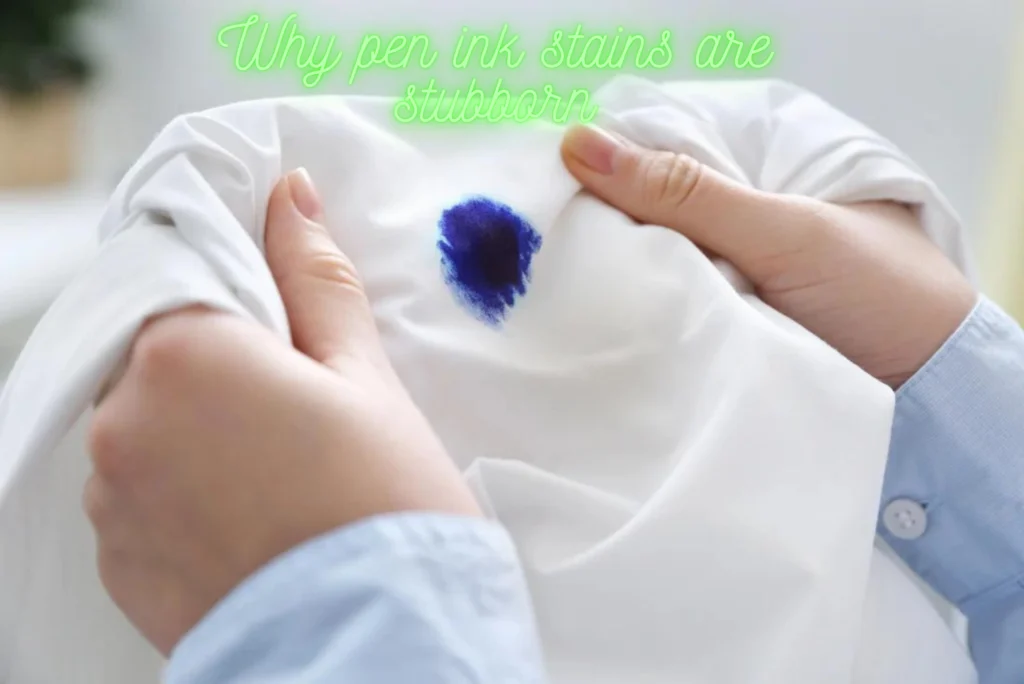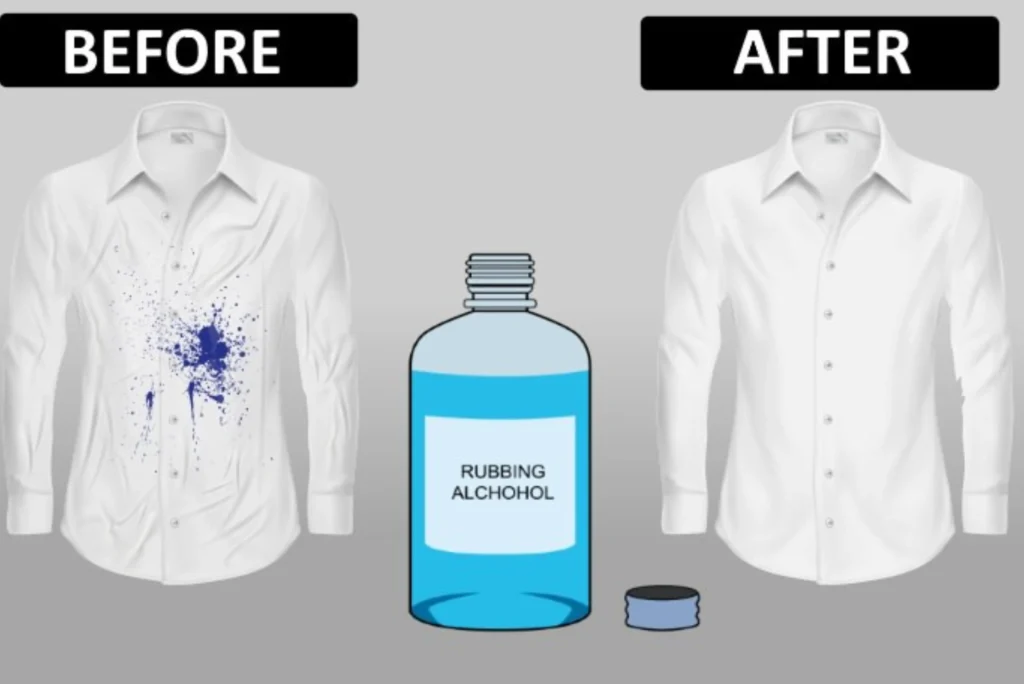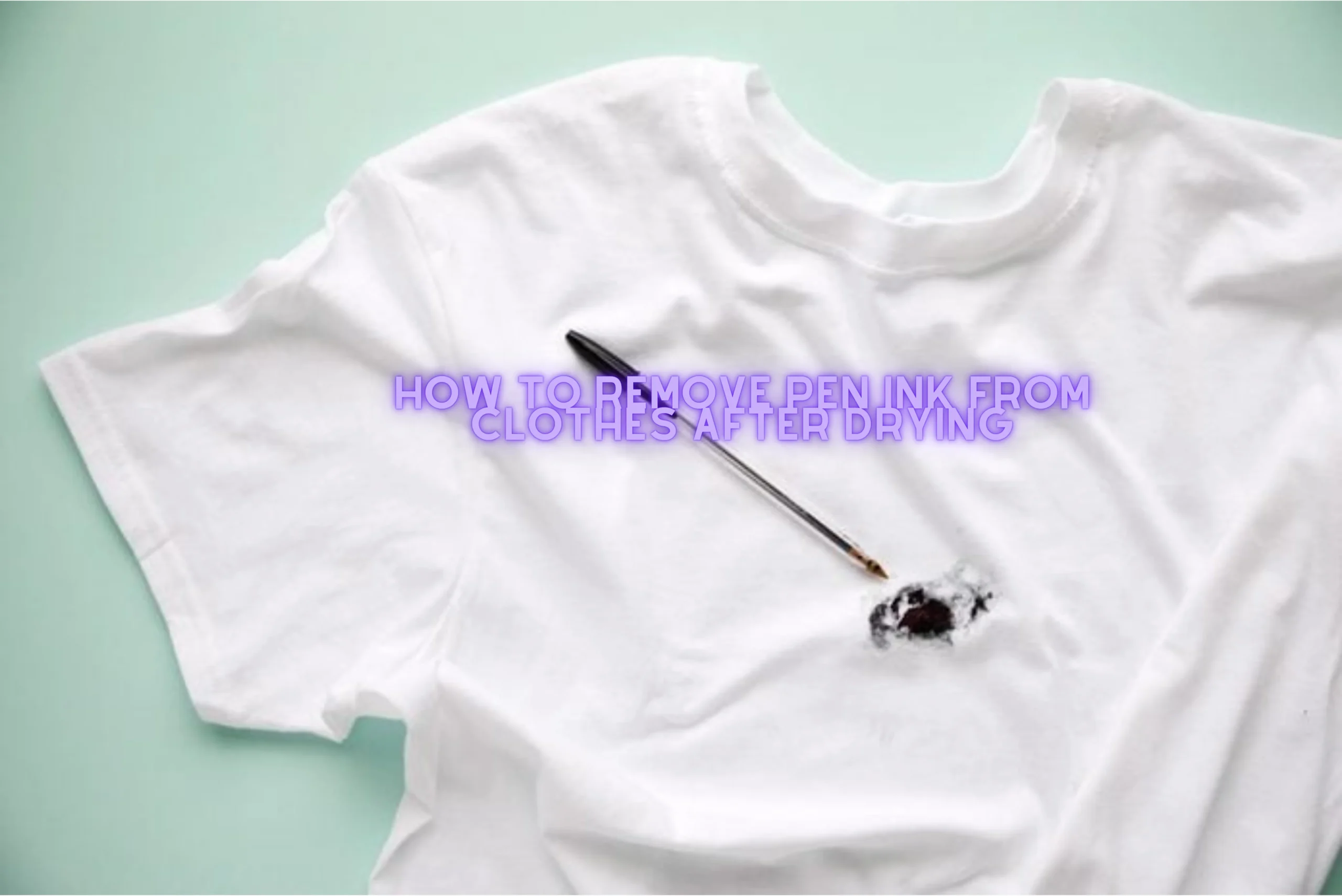Table of Contents
ToggleHow to Remove Pen Ink from Clothes After Drying Easy Methods
Find Out How to Take Pen Ink Out of Clothes After It Dries. Learn the strategies and tactics that professionals offer for effective stain removal at home. Once dry, pen ink stains on clothing may be difficult but not impossible to remove. Rubbing alcohol is one useful technique.
Just lightly dab the soiled area with a clean cloth that has been dampened with rubbing alcohol. Till the ink transfers from the fabric to the cloth, keep blotting. Another option is to use hairspray, which has alcohol in it to aid in the ink’s breakdown. Apply hairspray to the stain and let it stay for a few minutes before wiping with a fresh towel.
Making a cleaning solution by combining dish soap and hydrogen peroxide is an additional choice. After applying the solution to the stain and allowing it to settle for a time, blot using a fresh cloth. To be sure a cleaning solution won’t harm the clothing, always test it on a little, discrete section of it first. Once the stain has been treated, wash the clothing as normal. If the stain doesn’t go away, try the treatment again or think about getting aid from a specialist.
Understanding Pen Ink Stains
Pen ink stains may be especially difficult to remove because of the ink’s nature. Because different kinds of ink contain different colors and solvents, some stains are harder to get rid of than others. Moreover, ink tends to create connections on cloth that might be difficult to dissolve when it dries.
Different types of ink and their properties
to discoloring textiles. The following list of typical ink kinds and their attributes:
- Ballpoint Pen Ink:
Composition:Take out the ballpoint Pen stains usually include additives to regulate viscosity and drying time in addition to dyes or pigments contained in a solvent.
Properties: Take out the ballpoint ink. Oil-based stains on clothing are often more water-resistant and need specific cleaning methods.
- Gel Pen Ink:
Composition: Water-based gel pen ink is an ink that has dyes or pigments suspended in a gel-like material.
Properties: Because of their gel composition, which makes them stick firmly to clothes, gel pen ink stains may be difficult to remove from fabrics.
- Fountain Pen Ink:
Composition: Typically based on water, fountain pen ink might include pigment, dye, or a mix of the two.
Properties: Depending on the particular ink composition, fountain pen ink stains might vary, but water-based stain removal techniques usually work well on them.
- Permanent Marker Ink:
Composition: Strong pigments and solvents are used in permanent marker ink, which is intended to stick on surfaces forever.
Properties: Stains from permanent markers are very difficult to remove; harsh cleaning techniques may be needed to dissolve the ink bonds.
- Highlighter Ink:
Composition: Often bright and water-based, highlighter ink also includes pigments or dyes and additions to improve visibility.
Properties: It may be difficult to get rid of stains left by highlighter ink, particularly if they include fluorescent components that might react with cleaning solutions.
Why Pen Ink Stains Are Stubborn
The nature of the ink and how it interacts with fabric fibers make it difficult to remove old ink stains from colored clothing. Pen ink stains may be hard to get rid of for the following reasons:
Chemical Composition: Pigments, dyes, and binding chemicals used in many forms of ink have the ability to deeply permeate fabric fibers. Strong connections are formed between these elements and the cloth, making stain removal challenging.
Drying Time: Ink starts to dry fast on cloth once it comes into touch with it. It may get more embedded in the fibers as it dries, making removal more difficult.
Absorbency of Fabric: The degree of ink stain resistance is also influenced by the fabric’s absorbency. Ink may be more easily absorbed by porous materials like cotton or linen, making it more difficult to remove.
Chemical Reactions: Certain components of the ink may react chemically with the fabric, strengthening the ink’s binding to the fibers and making removal more challenging.
Multiple Components: Pigments, oils, and solvents are among the many ingredients that are often included in inks. The way each element interacts with the cloth may vary, making stain removal more difficult.
Surface Tension: Effectively targeting and removing stains may be difficult due to the surface tension of ink, which can cause the stain to spread and penetrate deeper into the fabric.

Precautions Before Removing Ink Stains
It’s important to take basic safety measures before using stain removal techniques to avoid causing more harm to your clothes. Make sure the washing technique you choose is safe for the fabric by always reading the labels on fabric care products. To make sure the cleaning solution doesn’t harm or discolor the clothing, it’s also a good idea to test it on a tiny, discrete section of the item.
Pen ink stains may be removed from clothing in a similar way as acrylic paint can be removed after drying. Both need acting quickly and using the proper cleaning techniques. Similar to ink stains, acrylic paint stains need quick attention; extra paint should be blotted off and dried paint should be scraped off.
Checking fabric care labels
Fabric Compatibility:
- The kind of fabric used to produce the garment—cotton, polyester, silk, or wool, for example—is indicated on fabric care labels. Different textiles respond differently to cleaning agents and techniques due to their unique qualities. The incorrect cleaning technique may cause stretching, shrinking, or color fading.
Recommended Cleaning Methods:
- Symbols or textual instructions that outline the suggested washing procedures for the clothing are often seen on fabric care labels. These techniques might include dry cleaning, hand washing, machine washing, or setting a certain temperature. Adhering to these guidelines contributes to maintaining the fabric’s quality and aesthetic appeal.
Special Instructions:
- Care labels on some clothing items may provide additional instructions or cautions. For instance, specific detergent and cautious handling may be necessary for fragile textiles like silk or lace. Disregarding these guidelines may cause harm to the fabric or cause its texture and look to change.
Precautions Against Heat:
- Since certain materials are heat sensitive, exposure to high temperatures might cause them to shrink or break. It is usually advised against using hot water or high-heat drying procedures on fabric care labels. Adhering to these guidelines assists in averting unintentional harm to the clothing.
Avoiding Harsh Chemicals:
- Labels for fabric care may also state if using bleach or other abrasive agents is safe for the material. Certain textiles are susceptible to bleach exposure, which may result in discoloration or weakening. Making sure the right cleaning products are used may be ensured by carefully reading the label.
Testing On A Small Area
Before trying to remove stains, it’s a good idea to test a cleaning solution on a tiny, discrete section of the clothing. This is why it’s so important to test in a limited area:
- Avoiding Damage:
particular cleaning solutions may cause particular materials to respond erratically, causing the fabric to fade, get discolored, or suffer other harm. You may determine if the solution is compatible with the fabric without running the risk of damaging the whole garment by trying it on a tiny, hardly noticeable region like the inner hem or seam.
- Checking for Colorfastness:
To find out whether the fabric is colorfast—that is, resistant to bleedthrough or fading—you may test a cleaning solution on a tiny section of the fabric. The fabric is not colorfast, and the cleaning solution may not be appropriate to use on the garment, if the color transfers or fades during the test.
- Assessing Reaction:
Cleaning solutions that are listed as safe for use on comparable materials may not work the same way on other fabrics. Before beginning stain removal, test the solution on a tiny area of the fabric to see if there are any negative responses, such as discoloration, textural changes, or damage to the fabric fibers.
- Adjusting Cleaning Method:
Should the test area exhibit any adverse responses to the cleaning solution, you have the option to modify your cleaning technique or choose an alternative solution that is less damaging to the fabric. This guarantees a more effective stain removal procedure and helps stop more harm.
- Preventing Visible Damage:
By testing on a tiny area, you may avoid apparent damage to the garment that would be difficult or impossible to restore, including bleach spots or color changes. It lets you evaluate the cleaning solution’s efficacy without sacrificing the garment’s overall look.
How To Remove Pen Ink From Clothes After Washing?
While it might be more difficult to remove ink stains from clothes after washing, it is still doable. Here’s a detailed tutorial on removing ink stains that have been entrenched after washing:

- Evaluate the Stain: Determine the extent of the ink stain before using any stain removal techniques. Check the cloth to see whether the ink has faded or is still visible.
- Pre-Treat the Stain: Before trying to remove an ink stain that remains visible after washing, give it some pre-treatment. Directly apply a dish soap and hydrogen peroxide combination or a stain remover to the discolored area. Allow it to permeate the cloth for a minimum of ten to fifteen minutes.
- Blot the Stain: Use a fresh paper towel or white cloth to blot the stain after pretreating it. To absorb as much of the ink and cleaning solution combination as possible, press down hard.
- Try Applying Hairspray or Rubbing Alcohol: If the stain doesn’t go away, try directly applying hairspray or rubbing alcohol to the ink stain. These two materials have the ability to dissolve ink and facilitate its removal from cloth. To absorb the ink, blot the stain with a fresh cloth or paper towel.
- Repetition is required. To fully eradicate stubborn ink stains, many treatments can be necessary. Until the stain starts to fade or vanish, continue the pre-treatment and blotting procedure.
- Clean the Clothes Once More: Once the stain has been treated, wash the item of clothing in cold water using a moderate detergent. This will assist in removing any last traces of ink and cleaning solution.
- Examine the outcomes: Examine the affected area to see if the ink stain has been entirely gone once the clothing has dried. If there are still residues of the stain, try removing it again or using a different technique until it is completely gone.
- Air-Dry the Garment: Until you’re certain the stain is gone, don’t use a dryer on the garment. The stain may get more embedded in the cloth due to heat from the dryer, making removal more challenging.
- Seek Professional Assistance: You may think about bringing the clothing to a professional cleaner if you are unable to get rid of the ink stain on your own. They could possess certain methods and materials that can efficiently eliminate difficult stains.
Methods for Removing Pen Ink Stains
Pen ink stains on clothing may be removed in a number of ways, from common home materials to specialty stain removers. Here are a few sensible choices:
- Rubbing Alcohol: Using rubbing alcohol to dab the stain can help loosen and remove the ink from the cloth.
- Hairspray: Blotting the discoloration with a clean towel after using an alcohol-containing hairspray may also work well.
- Dish Soap and Hydrogen Peroxide: To assist remove tough ink stains, combine dish soap and hydrogen peroxide to make a cleaning solution.
- Commercial Stain Remover: There are a lot of commercial stain removers on the market that are made especially to deal with stains from ink.
Using Rubbing Alcohol
Materials Needed
- Alcohol for rubbing (isopropyl alcohol)
- A cotton ball or a clean white cloth
- gentle cleaning agent
- Water
Blotting the Stain
- To stop the ink from transferring to the other side of the fabric, remove the pen ink from white clothes or place
- a cotton ball below the damaged spot.
- Apply some rubbing alcohol to a cotton ball or similar piece of clean white fabric.
- Using the cotton ball or cloth soaked in alcohol, gently dab the affected region. Refrain from rubbing as this
- may encourage the ink to spread more widely.
Repeat as Necessary
- Use rubbing alcohol to keep blotting the stain until the ink starts to come off the fabric and onto the cloth. As the cotton balls or cloths absorb ink, you may need to use more than one.
Rinsing
- Rinse the discolored area with water to get rid of any leftover alcohol and ink residue after most of the ink has been removed.
Washing the Garment
- As usual, wash the item in cold water with a moderate detergent. If there are any particular washing instructions, check the fabric care label.
Air-Drying
- Let the clothing air dry after washing. Heat should not be used as this might set any leftover ink stains into the cloth.
Inspecting the Results
- Take Pen Ink Out of Clothes Following Alcohol-Free Drying Check the affected area to make sure the ink stain has been totally gone once the clothing has dried. Try a different stain removal technique or repeat the rubbing alcohol procedure if any remnants of the stain are still visible.

Applying Hairspray
Another technique for getting rid of pen ink stains on clothes is using hairspray. Alcohol, which is included in hairspray, aids in the breakdown of ink and facilitates its removal from cloth. Here’s how to get rid of ink stains using hairspray:
Materials Needed:
- Hairspray—ideally an alcoholic variety—
- Use a paper towel or a clean white cloth.
- gentle cleaning agent
- Water
Preparation:
- With the ink stain facing up, place the affected clothing on a level surface.
Spraying the Stain:
- A few inches should separate the hairspray can from the ink stain.
A liberal volume of hairspray should be sprayed directly over the stain to ensure full coverage.
Allowing it to Sit:
- To enable the hairspray to permeate and dissolve the ink, let it rest on the stain for a few minutes.
Blotting the Stain:
- Use a fresh white cloth or paper towel to dab at the stain after the hairspray has had a chance to take effect. To absorb the ink and hairspray combination, press hard.
Repeating if Necessary:
- Reapply additional hairspray and blot until the stain starts to lift if the stain doesn’t go away.
Rinsing:
- Rinse the discolored area with water to remove any last traces of hairspray and ink once most of the ink has been gone.
Washing the Garment:
- As usual, wash the item in cold water with a moderate detergent. For precise washing guidelines, see the fabric care label.
Air-Drying:
- Let the clothing air dry after washing. Heat should not be used as this might set any leftover ink stains into the cloth.
Inspecting the Results:
- Examine the affected area of the clothing once it has dried to be sure the ink stain has been entirely gone. Try a different stain removal technique or repeat the hairspray treatment if any remains of the stain are still present.
Step-by-Step Guide to Removing Pen Ink Stains
Rubbing Alcohol Method:
- Apply rubbing alcohol on a clean towel to dampen it.
- Gently dab the discoloration, taking care not to let it spread.
- Blotting should continue until the ink is transferred to the fabric.
Hairspray Method:
- Apply hairspray containing alcohol on the stain.
- Give the hairspray a few minutes to settle.
- Using a fresh cloth, dab the stain until the ink starts to come out.
Dish Soap and Hydrogen Peroxide Method:
- To make a cleaning solution, combine hydrogen peroxide and dish soap in equal amounts.
- After applying the solution on the stain, let it ten to fifteen minutes to settle.
- Using a fresh cloth, blot the stain until the ink disappears.
Commercial Stain Remover Method:
- For optimal results, adhere to the stain removal product’s directions.
- After applying the product, let it seep into the cloth.
- Wash the clothing in accordance with the care guidelines.
Tips for Effective Stain Removal
- Move swiftly: Your chances of totally eliminating the stain increase with the timing of your treatment.
- Use cold water: Hot water might cause the stain to seep deeper into the cloth.
- The key is patience: It could take many sessions to completely remove stubborn stains.
What Not to Do When Removing Ink Stains
Steer clear of heat: Heat may cause the ink to cement into the cloth, making removal more difficult.
Avoid forcefully rubbing the stain as this may encourage the ink to spread and seep farther into the cloth.
Pen ink stains on clothing might be difficult to get rid of once they’ve dried, but not impossible. Through proper technique and precautionary measures, even the most difficult stains may be successfully removed, leaving your clothes appearing clean and new.
FAQs
Can I Use Bleach To Remove Ink Stains From Clothes?
It is not advised to use bleach to remove ink stains from cloth as it may not completely remove the stain and may even worsen the condition of the fabric.
What Should I Do If The Stain Doesn’t Come Out After The First Attempt?
Try continuing the cleaning procedure or using an alternative technique if the stain still remains following the first effort. It could take many treatments for certain stains to completely go away.
Can I Use A Hairdryer To Speed Up The Drying Process After Treating The Stain?
After cleaning the stain, it’s advisable to let the clothing air dry to prevent the stain from seeping further into the fabric.
Will Rubbing Alcohol Damage Delicate Fabrics?
Use rubbing alcohol carefully and try on a tiny area first as it may be harsh on fragile materials.
Is It Possible To Remove Old, Set-in Ink Stains From Clothes?
With the correct methods and perseverance, old ink stains on clothing may still be removed, even if it could be more difficult.












